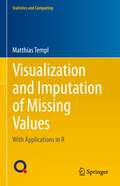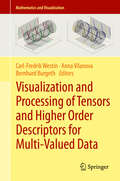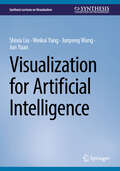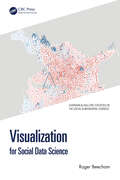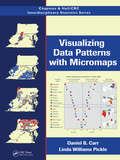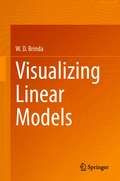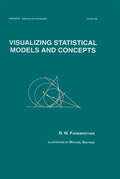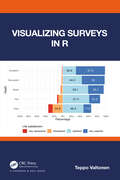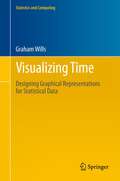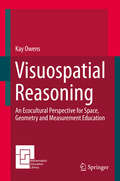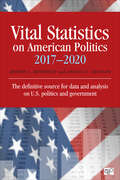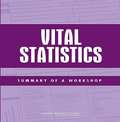- Table View
- List View
Visualization and Imputation of Missing Values: With Applications in R (Statistics and Computing)
by Matthias TemplThis book explores visualization and imputation techniques for missing values and presents practical applications using the statistical software R. It explains the concepts of common imputation methods with a focus on visualization, description of data problems and practical solutions using R, including modern methods of robust imputation, imputation based on deep learning and imputation for complex data. By describing the advantages, disadvantages and pitfalls of each method, the book presents a clear picture of which imputation methods are applicable given a specific data set at hand.The material covered includes the pre-analysis of data, visualization of missing values in incomplete data, single and multiple imputation, deductive imputation and outlier replacement, model-based methods including methods based on robust estimates, non-linear methods such as tree-based and deep learning methods, imputation of compositional data, imputation quality evaluation from visual diagnostics to precision measures, coverage rates and prediction performance and a description of different model- and design-based simulation designs for the evaluation. The book also features a topic-focused introduction to R and R code is provided in each chapter to explain the practical application of the described methodology. Addressed to researchers, practitioners and students who work with incomplete data, the book offers an introduction to the subject as well as a discussion of recent developments in the field. It is suitable for beginners to the topic and advanced readers alike.
Visualization and Processing of Tensors and Higher Order Descriptors for Multi-Valued Data
by Carl-Fredrik Westin Anna Vilanova Bernhard BurgethArising from the fourth Dagstuhl conference entitled Visualization and Processing of Tensors and Higher Order Descriptors for Multi-Valued Data (2011), this book offers a broad and vivid view of current work in this emerging field. Topics covered range from applications of the analysis of tensor fields to research on their mathematical and analytical properties. Part I, Tensor Data Visualization, surveys techniques for visualization of tensors and tensor fields in engineering, discusses the current state of the art and challenges, and examines tensor invariants and glyph design, including an overview of common glyphs. The second Part, Representation and Processing of Higher-order Descriptors, describes a matrix representation of local phase, outlines mathematical morphological operations techniques, extended for use in vector images, and generalizes erosion to the space of diffusion weighted MRI. Part III, Higher Order Tensors and Riemannian-Finsler Geometry, offers powerful mathematical language to model and analyze large and complex diffusion data such as High Angular Resolution Diffusion Imaging (HARDI) and Diffusion Kurtosis Imaging (DKI). A Part entitled Tensor Signal Processing presents new methods for processing tensor-valued data, including a novel perspective on performing voxel-wise morphometry of diffusion tensor data using kernel-based approach, explores the free-water diffusion model, and reviews proposed approaches for computing fabric tensors, emphasizing trabecular bone research. The last Part, Applications of Tensor Processing, discusses metric and curvature tensors, two of the most studied tensors in geometry processing. Also covered is a technique for diagnostic prediction of first-episode schizophrenia patients based on brain diffusion MRI data. The last chapter presents an interactive system integrating the visual analysis of diffusion MRI tractography with data from electroencephalography.
Visualization and Verbalization of Data (Chapman & Hall/CRC Computer Science & Data Analysis)
by Michael Greenacre Jörg BlasiusVisualization and Verbalization of Data shows how correspondence analysis and related techniques enable the display of data in graphical form, which results in the verbalization of the structures in data. Renowned researchers in the field trace the history of these techniques and cover their current applications.The first part of the book explains
Visualization for Artificial Intelligence (Synthesis Lectures on Visualization)
by Jun Yuan Shixia Liu Weikai Yang Junpeng WangThis book explores how visualization provides an effective way of improving not only the interpretability but also the generalization capabilities of machine learning models. It shows how visualization can bridge the gap between complex models or algorithms and human understanding while also facilitating data curation and model refinement. Therefore, visualization for artificial intelligence (VIS4AI) has become an emerging area that combines interactive visualization with machine learning techniques to maximize their values. VIS4AI techniques focus on every phase of the machine learning life cycle, from data preprocessing to model development and deployment. These techniques are closely aligned with the well-established data and model pipelines in machine learning. In the data pipeline, they contribute to improving data quality and feature quality, including training data cleaning and feature engineering. In the model pipeline, they support (1) model development by focusing on model understanding, diagnosis, and steering; and (2) model deployment by enabling decision explanation, model performance monitoring, and model maintenance. This book provides a framework of VIS4AI and introduces the associated techniques in the two pipelines. It emphasizes the importance of interactive visualization in AI and presents various visualization techniques for different purposes. It also discusses the challenges and opportunities of VIS4AI and proposes several promising research topics for future work, such as improving training data using complementary modalities, online training diagnosis, fitting the dynamic nature of AI systems, and interactively pre-training and adapting foundation models. Overall, this book aims to serve as a resource for researchers and practitioners interested in both visualization and artificial intelligence.
Visualization for Social Data Science (Chapman & Hall/CRC Statistics in the Social and Behavioral Sciences)
by Roger Beecham"This is an important book on an important topic. I particularly like the examples showing different visualizations of the same data and the parallel presentation of graphics and code. And I absolutely love the chapter on visual storytelling. I can't wait to use this book in my classes."- Andrew Gelman, Department of Statistics and Department of Political Science, Columbia University, New York"A book that gives learners the inspiration, knowledge and worked examples to create cutting edge visualisations of their own."- James Chesire, Professor of Geographic Information and Cartography, University College LondonVisualization for Social Data Science provides end-to-end skills in visual data analysis. The book demonstrates how data graphics and modern statistics can be used in tandem to process, explore, model and communicate data-driven social science. It is packed with detailed data analysis examples, pushing you to do visual data analysis. As well as introducing, and demonstrating with code, a wide range of data visualizations for exploring patterns in data, Visualization for Social Data Science shows how models can be integrated with graphics to emphasise important structure and de-emphasise spurious structure and the role of data graphics in scientific communication -- in building trust and integrity. Many of the book’s influences are from data journalism, as well as information visualization and cartography. Each chapter introduces statistical and graphical ideas for analysis, underpinned by real social science datasets. Those ideas are then implemented via principled, step-by-step, workflows in the programming environment R. Key features include:• Extensive real-world data sets and data analysis scenarios in Geography, Public Health, Transportation, Political Science;• Code examples fully-integrated into main text, with code that builds in complexity and sophistication;• Quarto template files for each chapter to support literate programming practices;• Functional programming examples, using tidyverse, for generating empirical statistics (bootstrap resamples, permutation tests) and working programmatically over model outputs;• Unusual but important programming tricks for generating sophisticated data graphics such as network visualizations, dot-density maps, OD maps, glyphmaps, icon arrays, hypothetical outcome plots and graphical line-ups plots. Every data graphic in the book is implemented via ggplot2.• Chapters on uncertainty visualization and data storytelling that are uniquely accompanied with detailed, worked examples.
Visualizing Baseball (ASA-CRC Series on Statistical Reasoning in Science and Society)
by Jim AlbertVisualizing Baseball provides a visual exploration of the game of baseball. Graphical displays are used to show how measures of performance, at the team level and the individual level, have changed over the history of baseball. Graphs of career trajectories are helpful for understanding the rise and fall of individual performances of hitters and pitchers over time. One can measure the contribution of plays by the notion of runs expectancy. Graphs of runs expectancy are useful for understanding the importance of the game situation defined by the runners on base and number of outs. Also the runs measure can be used to quantify hitter and pitch counts and the win probabilities can be used to define the exciting plays during a baseball game. Special graphs are used to describe pitch data from the PitchFX system and batted ball data from the Statcast system. One can explore patterns of streaky performance and clutch play by the use of graphs, and special plots are used to predict final season batting averages based on data from the middle of the season. This book was written for several types of readers. Many baseball fans should be interested in the topics of the chapters, especially those who are interested in learning more about the quantitative side of baseball. Many statistical ideas are illustrated and so the graphs and accompanying insights can help in promoting statistical literacy at many levels. From a practitioner’s perspective, the chapters offer many illustrations of the use of a modern graphics system and R scripts are available on an accompanying website to reproduce and potentially improve the graphs in this book.
Visualizing Data Patterns with Micromaps (Chapman & Hall/CRC Interdisciplinary Statistics)
by Daniel B. Carr Linda Williams PickleAfter more than 15 years of development drawing on research in cognitive psychology, statistical graphics, computer science, and cartography, micromap designs are becoming part of mainstream statistical visualizations. Bringing together the research of two leaders in this field, Visualizing Data Patterns with Micromaps presents the many design vari
Visualizing Financial Data
by Piotr Kaczmarek Julie RodriguezA fresh take on financial data visualization for greater accuracy and understanding Visualizing Financial Data shows you how to design dynamic, best-of-breed visualizations for better communication of financial data. This book provides a comprehensive set of visualizations tailored to the most common requirements for corporate financial reporting, as well as portfolio, mutual fund, and hedge fund management. This highly visual, full color book showcases a series of cases that push data communication conventions forward, demonstrating and contrasting traditional bar, line, and pie charts against more modern visual methods. The companion website features all of the visualizations discussed, and provides the underlying datasets that you can use to practice on your own or customize the visualizations for your own use. Get a fresh take on visualizations and insight you need to communicate financial data better than ever before. Expand the boundaries of data visualization conventions Optimize data communications, understanding, and disclosure Learn new approaches to traditional charts and visualizations Create exemplary visualizations Visualizing Financial Data shows you newer, better ways of communicating the full meaning of the data, to support efficient, timely, and effective decision-making.
Visualizing Linear Models
by W. D. BrindaThis book provides a visual and intuitive coverage of the core theory of linear models. Designed to develop fluency with the underlying mathematics and to build a deep understanding of the principles, it's an excellent basis for a one-semester course on statistical theory and linear modeling for intermediate undergraduates or graduate students. Three chapters gradually develop the essentials of linear model theory. They are each preceded by a review chapter that covers a foundational prerequisite topic. This classroom-tested work explores two distinct and complementary types of visualization: the “observations picture” and the “variables picture.” To improve retention of material, this book is supplemented by a bank of ready-made practice exercises for students. These are available for digital or print use.
Visualizing Mathematics with 3D Printing
by Henry SegermanThe first book to explain mathematics using 3D printed models.Winner of the Technical Text of the Washington PublishersWouldn’t it be great to experience three-dimensional ideas in three dimensions? In this book—the first of its kind—mathematician and mathematical artist Henry Segerman takes readers on a fascinating tour of two-, three-, and four-dimensional mathematics, exploring Euclidean and non-Euclidean geometries, symmetry, knots, tilings, and soap films. Visualizing Mathematics with 3D Printing includes more than 100 color photographs of 3D printed models. Readers can take the book’s insights to a new level by visiting its sister website, 3dprintmath.com, which features virtual three-dimensional versions of the models for readers to explore. These models can also be ordered online or downloaded to print on a 3D printer. Combining the strengths of book and website, this volume pulls higher geometry and topology out of the realm of the abstract and puts it into the hands of anyone fascinated by mathematical relationships of shape. With the book in one hand and a 3D printed model in the other, readers can find deeper meaning while holding a hyperbolic honeycomb, touching the twists of a torus knot, or caressing the curves of a Klein quartic.
Visualizing Mathematics: The Role of Spatial Reasoning in Mathematical Thought (Research in Mathematics Education)
by Michael T. Battista Kelly S. MixThis unique volume surveys recent research on spatial visualization in mathematics in the fields of cognitive psychology and mathematics education. The general topic of spatial skill and mathematics has a long research tradition, but has been gaining attention in recent years, although much of this research happens in disconnected subfields. This volume aims to promote interaction between researchers, not only to provide a more comprehensive view of spatial visualization and mathematics, but also to stimulate innovative new directions in research based on a more coordinated effort. It features ten chapters authored by leading researchers in cognitive psychology and mathematics education, as well as includes dynamic commentaries by mathematics education researchers on cognitive psychology chapters, and by cognitive psychologists on mathematics education chapters. Among the topics included: From intuitive spatial measurement to understanding of units. Spatial reasoning: a critical problem-solving tool in children’s mathematics strategy tool-kit. What processes underlie the relation between spatial skill and mathematics? Learning with and from drawing in early years geometry. Communication of visual information and complexity of reasoning by mathematically talented students. Visualizing Mathematics makes substantial progress in understanding the role of spatial reasoning in mathematical thought and in connecting various subfields of research. It promises to make an impact among psychologists, education scholars, and mathematics educators in the convergence of psychology and education.
Visualizing Music
by Eric IsaacsonTo feel the emotional force of music, we experience it aurally. But how can we convey musical understanding visually?Visualizing Music explores the art of communicating about music through images. Drawing on principles from the fields of vision science and information visualization, Eric Isaacson describes how graphical images can help us understand music. By explaining the history of music visualizations through the lens of human perception and cognition, Isaacson offers a guide to understanding what makes musical images effective or ineffective and provides readers with extensive principles and strategies to create excellent images of their own. Illustrated with over 300 diagrams from both historical and modern sources, including examples and theories from Western art music, world music, and jazz, folk, and popular music, Visualizing Music explores the decisions made around image creation. Together with an extensive online supplement and dozens of redrawings that show the impact of effective techniques, Visualizing Music is a captivating guide to thinking differently about design that will help music scholars better understand the power of musical images, thereby shifting the ephemeral to material.
Visualizing Statistical Models And Concepts
by R.W. Farebrother Michael SchynsExamines classic algorithms, geometric diagrams, and mechanical principles for enhancing visualization of statistical estimation procedures and mathematical concepts in physics, engineering, and computer programming.
Visualizing Surveys in R
by Teppo ValtonenVisualizing Surveys in R is about creating static, print quality figures from survey data using R. The focus is not, for example, on statistical analysis of survey data, but rather on giving concrete solutions for typical problems in visualizing survey data. While there are many excellent books on data visualization, surveys and R, the aim of this book is to bring these topics together, and offer practical instructions for visualizing surveys in R. Features • Introduction to survey data: variables, categories, and scales • Description of a process for visualizing survey data • Recommendations for reading survey data into R • Advice on building a survey dataset in R to facilitate versatile plotting • Step-by-step recipes in R for creating useful plots from survey data The book is intended for researchers who regularly use surveys and are interested in learning how to seize the vast possibilities and the flexibility of R in survey analysis and visualizations. The book is also valuable for psychologists, marketeers, HR personnel, managers, and other professionals who wish to standardize and automate the process for visualizing survey data. Finally, the book is suitable as a course textbook, either more widely on survey studies, or more strictly on visualizing survey data in R.
Visualizing Time
by Graham WillsArt, or Science? Which of these is the right way to think of the field of visualization? This is not an easy question to answer, even for those who have many years experience in making graphical depictions of data with a view to help people understand it and take action. In this book, Graham Wills bridges the gap between the art and the science of visually representing data. He does not simply give rules and advice, but bases these on general principles and provide a clear path between them This book is concerned with the graphical representation of time data and is written to cover a range of different users. A visualization expert designing tools for displaying time will find it valuable, but so also should a financier assembling a report in a spreadsheet, or a medical researcher trying to display gene sequences using a commercial statistical package.
Visuospatial Reasoning
by Kay OwensThis book develops the theoretical perspective on visuospatial reasoning in ecocultural contexts, granting insights on how the language, gestures, and representations of different cultures reflect visuospatial reasoning in context. For a number of years, two themes in the field of mathematics education have run parallel with each other with only a passing acquaintance. These two areas are the psychological perspective on visuospatial reasoning and ecocultural perspectives on mathematics education. This volume examines both areas of research and explores the intersection of these powerful ideas. In addition, there has been a growing interest in sociocultural aspects of education and in particular that of Indigenous education in the field of mathematics education. There has not, however, been a sound analysis of how environmental and cultural contexts impact visuospatial reasoning, although it was noted as far back as the 1980s when Alan Bishop developed his duality of visual processing and interpreting visual information. This book provides this analysis and in so doing not only articulates new and worthwhile lines of research, but also uncovers and makes real a variety of useful professional approaches in teaching school mathematics. With a renewed interest in visuospatial reasoning in the mathematics education community, this volume is extremely timely and adds significantly to current literature on the topic.
Vital Directions for Mathematics Education Research
by Keith R LeathamThis book provides a collection of chapters from prominent mathematics educators in which they each discuss vital issues in mathematics education and what they see as viable directions research in mathematics education could take to address these issues. All of these issues are related to learning and teaching mathematics. The book consists of nine chapters, seven from each of seven scholars who participated in an invited lecture series (Scholars in Mathematics Education) at Brigham Young University, and two chapters from two other scholars who are writing reaction papers that look across the first seven chapters. The recommendations take the form of broad, overarching principles and ideas that cut across the field. In this sense, this book differs from classical "research agenda projects," which seek to outline specific research questions that the field should address around a central topic.
Vital Statistics on American Politics
by Jeffrey L. Bernstein Amanda C. ShannonThere is no other source that provides in one place the wide range and depth of insight found in Vital Statistics on American Politics (VSAP), published since 1988. VSAP provides historical and statistical information on all aspects of American politics: Political parties Voter turnout Public opinion Campaign finance Media perspective and influence, congressional membership and voting patterns The presidency and executive branch Military policy and spending Supreme Court and federal court make-up and caseloads Foreign, social, and economic policy In over 230 tables and figures, students and professional researchers will find chapters devoted to key subject areas such as elections and political parties, public opinion and voting, the media, the three branches of U.S. government, foreign, military, social and economic policy, and much more. This book provides a vivid and multifaceted portrait of the broad spectrum of United States politics and policies. Along with updated and new data content, this edition offers brand new data literacy lessons that take a "guide on the side" approach to teach data researchers how to wade through the sea of data and do the difficult work of grappling for the meaning of the data on their own. Lessons include understanding descriptive representation data, comparing data over time, noticing gaps in data, unpacking dichotomies of public opinion, and more.
Vital Statistics on American Politics
by Jeffrey L. Bernstein Amanda C. ShannonThere is no other source that provides in one place the wide range and depth of insight found in Vital Statistics on American Politics (VSAP), published since 1988. VSAP provides historical and statistical information on all aspects of American politics: Political parties Voter turnout Public opinion Campaign finance Media perspective and influence, congressional membership and voting patterns The presidency and executive branch Military policy and spending Supreme Court and federal court make-up and caseloads Foreign, social, and economic policy In over 230 tables and figures, students and professional researchers will find chapters devoted to key subject areas such as elections and political parties, public opinion and voting, the media, the three branches of U.S. government, foreign, military, social and economic policy, and much more. This book provides a vivid and multifaceted portrait of the broad spectrum of United States politics and policies. Along with updated and new data content, this edition offers brand new data literacy lessons that take a "guide on the side" approach to teach data researchers how to wade through the sea of data and do the difficult work of grappling for the meaning of the data on their own. Lessons include understanding descriptive representation data, comparing data over time, noticing gaps in data, unpacking dichotomies of public opinion, and more.
Vital Statistics: Summary of a Workshop
by National Research Council of the National AcademiesVital statistics, the records of birth and death, are a critical national information resource for understanding public health. Over the past few decades, the specific program that gathers the data has evolved into a complex cooperative program between the federal and state governments for social measurement. The Vital Statistics Cooperative Program (VSCP) is currently maintained by the National Center for Health Statistics (NCHS). The U.S. vital statistics system relies on the original information reported by myriad individuals, channeled through varying state and local information systems, and coordinated and processed by a federal statistical agency that has experienced relatively flat funding for many years. The challenges facing the vital statistics system and the continuing importance of the resulting data make it an important topic for examination. A workshop, held by the National Academies and summarized in this volume, considered the importance of adequate vital statistics. In particular, the workshop assessed both current and emerging uses of the data, considered the methodological and organizational features of compiling vital data, and identified possible visions for the vital statistics program.
Vitiation of Contracts
by Gareth SparkVitiation of Contracts proposes a new theory to explain the rationale of general vitiating factors in English contract law. It provides a clear link to voluntariness as the foundation of contractual liability and compares the English position, in light of this theory, with the Principles of International Commercial Contracts (PICC), the Principles of European Contract Law (PECL), the Draft Common Frame of Reference (DCFR) and the US Restatement (Second) of Contracts.
Vito Volterra
by Giovanni Paoloni Angelo Guerraggio Kim WilliamsVito Volterra (1860-1940) was one of the most famous representatives of Italian science in his day. Angelo Guerragio and Giovanni Paolini analyze Volterra's most important contributions to mathematics and their applications, as well as his outstanding organizational achievements in scientific policy. Volterra was one of the founding fathers of functional analysis and the author of fundamental contributions in the field of integral equations, elasticity theory and population dynamics (Lotka-Volterra model). He delivered keynote lectures on the occasion of the International Congresses of Mathematicians held in Paris (1900), Rome (1908), Strasbourg (1920) and Bologna (1928). He became involved in the scientific development in united Italy and was appointed senator of the kingdom in 1905. One of his numerous non-mathematical activities was founding the National Research Council (Consiglio Nazionale delle Ricerche, CNR). During the First World War he was active in military research. After the war he took a clear stand against fascism, which was the starting point for his exclusion. In 1926 he resigned as president of the world famous Accademia Nazionale dei Lincei and was later on excluded from the academy. In 1931 he was one of the few university lecturers who denied to swear an oath of allegiance to the fascistic regime. In 1938 he suffered from the impact of the racial laws. The authors draw a comprehensive picture of Vito Volterra, both as a great mathematician and an organizer of science.
Vitushkin’s Conjecture for Removable Sets
by James DudziakVitushkin's conjecture, a special case of Painlevé's problem, states that a compact subset of the complex plane with finite linear Hausdorff measure is removable for bounded analytic functions if and only if it intersects every rectifiable curve in a set of zero arclength measure. Chapters 1-5 of the book provide important background material on removability, analytic capacity, Hausdorff measure, arclength measure, and Garabedian duality that will appeal to many analysts with interests independent of Vitushkin's conjecture. The fourth chapter contains a proof of Denjoy's conjecture that employs Melnikov curvature. A brief postscript reports on a deep theorem of Tolsa and its relevance to going beyond Vitushkin's conjecture. This text can be used for a topics course or seminar in complex analysis. To understand it, the reader should have a firm grasp of basic real and complex analysis.
